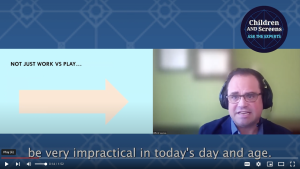
Shimi Kang, MD, FRCPC (Psychiatrist; author of “The Tech Solution,” Clinical Associate Professor, The University of British Columbia) explains the chemical mechanisms by which persuasive design promotes addictive internet use and advocates for limiting and monitoring tech use for a healthy media diet at #AskTheExperts webinar “The Social Brain on Screens” on April 11, 2023.
[Dr. Shimi Kang] So let’s look at the ingredients of the diet. The sugar of the the life diet and our food is dopamine. Dopamine is that neurochemical of pleasure. It’s embedded in technology, its design. It’s called persuasive design. The purposeful manipulation of the brain’s dopamine to give us those little hits of pleasure, whether it’s when we see a light, whether it’s when we level up in a video game, whether we get that little ping on eBay when we’re doing online shopping, all of that is designed to enhance that dopamine release experience. That’s what makes tech highly addictive and it is addictive. Internet addiction, gaming disorder, Internet Use Disorder, or medical diagnoses in the ICD-10, which is the European – classification system. And they will be coming to North America by all predictions in my field. So the image in front of you for the sugar is cookies. And again, it’s the limits and monitoring, just like we limit and monitor sugar for in our children’s diet, we have to do the same with technology. And as time goes on, we can it can let that go a little bit again, just like we don’t hand children keys to a car, we give them lessons, we let them go on local roads first. So start with tax in terms of, you know, text messaging for carpool and homework. Those are the local roads. And if your children are able to do that successfully, then maybe they can go on the highway of social media. But then you monitor it and you sit with them as you heard, and you can take back those keys if you need it. That’s the scaffolding required.
View the Full Webinar

The Social Brain on Screens
What are the functions of the social brain in childhood and what strategies can encourage healthy social development in youth?
Moriah Thomason, PhD
Barakett Associate Professor and Director of Pediatric Neuroimaging; Vice Chair for Research
Eva Telzer, PhD
Co-Director; Associate Professor of Psychology and Neuroscience
Shimi Kang, MD, FRCPC
Psychiatrist; Best-selling author of The Tech Solution; Clinical Associate Professor
Georgene Troseth, PhD
Professor of Psychology




